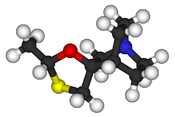Cevimeline (trade name Evoxac ) is a parasympathomimetic and muscarinic agonist ,[1] M1 and M3 receptors . It is used in the treatment of dry mouth and especially associated with Sjögren's syndrome .
Mechanism of action [ ] By activating the M3 receptors of the parasympathetic nervous system , cevimeline stimulates secretion by the salivary glands , thereby alleviating dry mouth.
Side effects [ ] Known side effects include nausea , vomiting , diarrhea , excessive sweating , rash , headache , runny nose , cough , drowsiness , hot flashes , blurred vision , and difficulty sleeping .[2]
Contraindications include asthma and angle closure glaucoma .[citation needed
See also [ ] Pilocarpine — a similar parasympathomimetic medication for dry mouth (xerostomia )Bethanechol — a similar muscarinic parasympathomimetic with longer-lasting effectReferences [ ]
^ Ono M, Takamura E, Shinozaki K, et al. (July 2004). "Therapeutic effect of cevimeline on dry eye in patients with Sjögren's syndrome: a randomized, double-blind clinical study". Am. J. Ophthalmol . 138 (1): 6–17. doi :10.1016/j.ajo.2004.02.010 . PMID 15234277 . ^ [1] MedicineNet: Cevimeline. Accessed 10/12/2007
External links [ ] show mAChRs
Agonists Antagonists
3-Quinuclidinyl benzilate 4-DAMP Aclidinium bromide (+formoterol )Abediterol AF-DX 384 Ambutonium bromide Anisodamine Anisodine Antihistamines (first-generation) (e.g., brompheniramine , buclizine , captodiame , chlorphenamine (chlorpheniramine) , cinnarizine , clemastine , cyproheptadine , dimenhydrinate , dimetindene , diphenhydramine , doxylamine , meclizine , mequitazine , perlapine , phenindamine , pheniramine , phenyltoloxamine , promethazine , propiomazine , triprolidine )Atropine Atropine methonitrate Atypical antipsychotics (e.g., clozapine , fluperlapine , olanzapine (+fluoxetine ), , quetiapine , tenilapine , zotepine )Benactyzine Benzatropine (benztropine) Benzilone Benzilylcholine mustard Benzydamine Biperiden Bornaprine Camylofin CAR-226,086 CAR-301,060 CAR-302,196 CAR-302,282 CAR-302,668 Caramiphen Cimetropium bromide Clidinium bromide Cloperastine CS-27349 Cyclobenzaprine Cyclopentolate Darifenacin Desfesoterodine Dexetimide Dicycloverine (dicyclomine) Dihexyverine Difemerine Diphemanil metilsulfate Ditran Drofenine EA-3167 EA-3443 EA-3580 EA-3834 Emepronium bromide Etanautine Etybenzatropine (ethybenztropine) Fenpiverinium Fentonium bromide Fesoterodine Flavoxate Glycopyrronium bromide (+beclometasone/formoterol , +indacaterol )Hexocyclium Himbacine Homatropine Imidafenacin Ipratropium bromide (+salbutamol )Isopropamide Hyoscyamine Mamba toxin 3 Mamba toxin 7 Mazaticol Mebeverine Meladrazine Mepenzolate Methantheline Methoctramine Methylatropine Methylhomatropine Methylscopolamine Metixene Muscarinic toxin 7 N-Ethyl-3-piperidyl benzilate N-Methyl-3-piperidyl benzilate Nefopam Octatropine methylbromide (anisotropine methylbromide) Orphenadrine Otenzepad (AF-DX 116) Otilonium bromide Oxapium iodide Oxitropium bromide Oxybutynin Oxyphencyclimine Oxyphenonium bromide PD-102,807 PD-0298029 Penthienate Pethidine Phenglutarimide Phenyltoloxamine Pipenzolate bromide Piperidolate Pirenzepine Piroheptine Pizotifen Poldine Pridinol Prifinium bromide Procyclidine Profenamine (ethopropazine) Propantheline bromide Propiverine Quinidine 3-Quinuclidinyl thiochromane-4-carboxylate Revefenacin Rociverine Scopolamine (hyoscine) Scopolamine butylbromide (hyoscine butylbromide) Sofpironium bromide Solifenacin SSRIs femoxetine , paroxetine )Telenzepine Terodiline Tetracyclic antidepressants (e.g., amoxapine , maprotiline , mianserin , mirtazapine )Tiemonium iodide Timepidium bromide Tiotropium bromide Tofenacin Tolterodine Tricyclic antidepressants (e.g., amitriptyline (+perphenazine ), amitriptylinoxide , butriptyline , cidoxepin , clomipramine , desipramine , , dibenzepin , dosulepin (dothiepin) , doxepin , imipramine , lofepramine , nitroxazepine , northiaden (desmethyldosulepin) , nortriptyline , protriptyline , quinupramine , trimipramine )Tridihexethyl Trihexyphenidyl Trimebutine Tropatepine Tropicamide Trospium chloride Typical antipsychotics (e.g., chlorpromazine , chlorprothixene , cyamemazine (cyamepromazine) , loxapine , mesoridazine , thioridazine )Umeclidinium bromide (+vilanterol )WIN-2299 Xanomeline
Precursors (and prodrugs ) See also: Receptor/signaling modulators • Nicotinic acetylcholine receptor modulators • Acetylcholine metabolism/transport modulators

